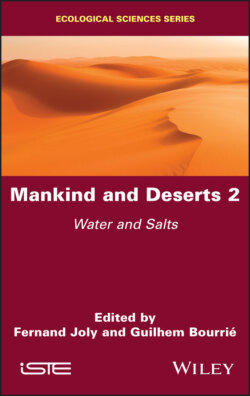Читать книгу Mankind and Deserts 2 - Группа авторов - Страница 6
Оглавление
Introduction: Water in Deserts
Because of the minuscule amounts of water and their meteoric variability, the discipline of arid zone hydrology is one of the highest forms of art and science.
V. Kotwicki, Floods of Lake Eyre
“Ce qui embellit le désert, dit le petit prince, c’est qu’il cache un puits quelque part…” (“What makes the desert beautiful,” said the Little Prince, “is that somewhere it hides a well…”)
Antoine de Saint-Exupéry
It is because of its extreme scarcity, or indeed its absence, that water is so important in a desert, even when it is invisible, when one is searching for it or it is altogether lacking. It is exceptional to find open water sources (there are long periods when these open water bodies simply do not exist) and they are most often found at some depth. Finding water, collecting it, transporting it, using it carefully and storing it are all key issues to be resolved in desert life. Sometimes there is a lack of water because the excessive aridity results in deficient hydrology and a lack of wild water (Joly 2006), while at other times there is a poorly developed hydraulic system, such that domesticated water resources (Prosper-Laget 2001) cannot fulfill the needs of the population they serve.
Sometimes the areas involved are vast, like the Sahara, Arabia or central Australia; and, sometimes, there are smaller spaces where water, though present, is unequally distributed, as is the case in central Asia, Mongolia, western North America and the Andes. The tragedy here is that across these regions there is a permanent imbalance between available water resources (highly limited) and the requirements of the ecosystem for ordinary consumption and development (Margat and Tiercelin 1998).
I.1. Hydrology – wild water
Hydrology is the science of water (Cosandey and Robinson 2000) and it is not a discipline that can be easily applied to deserts (Margat 1985). As with climatological data, this scientific field is hindered by a series of restrictions, arising, principally, from small human presence and the highly discontinuous nature of hydrological phenomena, which are scattered through time as well as space. There are, of course, a relatively large number of qualitative observations from nomads and travelers. However, these are often not very objective, difficult to access and unreliable. The quantitative observations that are archived are better monitored and valid, but they are far too scattered as they usually focus on inhabited sites: military or administrative stations, oases, mining or agricultural installations and construction sites.
Certain phenomena can also be studied using isotopic or magnetic labeling (Adar and Leibundgut 1995), through various mathematical or statistical models (Band 1985; Dassargues 2000) and, above all, through remote sensing (Mering 2008), especially phenomena such as floods, humidity in air and soil, and even the presence of subterranean water (Timmermans and Meijerink 1999). There have also been some systematic projects devoted to observation and measurement (Braquaval 1957; Dubreuil 1972; Roose 1977). However, apart from the large rivers, certain semi-permanent water courses and some large basins of economic interest (mainly related to oil), there has been rather a meager amount of data collected, and what does exist is fragmented, dispersed and patchy. This is partly because many desert zones lie in developing countries, which have economical constraints as well as a restricted qualified workforce. However, it is also because even among the large powers, such as the United States, Russia or China, equipment and regular tracking are allocated only to arid zones considered to be economically “useful” or profitable (Lacoste 2001).
I.2. References
Adar, E. M. and C. Leibundgut, eds. (1995). Vienna Symposium, 1994, Applications of tracers in arid zone hydrology. Red Books 232. Wallingford, UK: IAHS. 452 pp.
Band, L. (1985). “Simulation of slope development and the magnitude and frequency of overland flow erosion in an abandoned hydraulic gold mine.” In. Models in Geomorphology. Ed. by M. Woldenberg. Winchester, Mass.: Allen and Unwin, pp. 191–211.
Braquaval, R. (1957). Études d’écoulement en régime désertique - Massif de l’Ennedi et région nord de Mortchai. Paris: ORSTOM. 92 pp.
Cosandey, C. and M. Robinson (2000). Hydrologie continentale. Paris: A. Colin. 360 pp.
Dassargues, A., ed. (2000). Tracers and modelling in hydrogeology. Red Books 262. Wallingford, UK: IAHS. 571 pp.
Dubreuil, P. (1972). Recueil des données de base des bassins représentatifs et expérimentaux - Années 1951–1969. Paris: ORSTOM. 916 pp.
Joly, F. (2006). “Les eaux sauvages des régions arides - Notions de base sur l’hydrologie des déserts.” In Geomorphologie: relief, processus, environnement 4, pp. 285–298.
Lacoste, Y. (2001). “Géopolitique de l’eau.” In Hérodote 102, pp. 3–18.
Margat, J. (1985). “Hydrologie et ressources en eau des zones arides.” In Bulletin de la Société Géologique de France, pp. 1009–1020.
Margat, J. and J.-R. Tiercelin, eds. (1998). L’eau en questions: enjeux du XXIe siècle. Paris: Romillat. 301 pp.
Mering, C. (2008). “Analyse et cartographie des formations superficielles à partir d’images optiques et radar.” In. LES FORMATIONS SUPERFICIELLES, Genèse - Typologie — Classification — Paysages et environnement - Ressources et risques. Ed. by Y. Dewolf and G. Bourrié. Paris: Ellipses. Chap. 11.2, pp. 413–439.
Prosper-Laget, V., ed. (2001). Eaux sauvages, eaux domestiquées. Hommage à Lucette Davy. Aix-en-Provence: Presses Universitaires de Provence. 341 pp.
Roose, É. (1977). Érosion et ruissellement en Afrique de l’Ouest. Travaux et Documents 78. Paris: Éditions de l’ORSTOM. 108 pp.
Timmermans, W. and A. Meijerink (1999). “Remotely sensed actual evapotranspiration: implications for groundwater management in Botswana.” In International Journal of Applied Earth Observation and Geoinformation 01/1999 (3-4-1), pp. 222–233.
Introduction written by Fernand JOLY.
